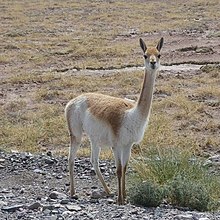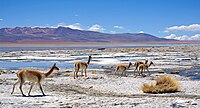Vicuña
This article needs additional citations for verification. (February 2022) |
| Vicuña | |
|---|---|

| |
| Vicuña in the Atacama Desert | |
| Scientific classification | |
| Domain: | Eukaryota |
| Kingdom: | Animalia |
| Phylum: | Chordata |
| Class: | Mammalia |
| Order: | Artiodactyla |
| Family: | Camelidae |
| Genus: | Lama |
| Species: | L. vicugna
|
| Binomial name | |
| Lama vicugna (Molina, 1782)
| |

| |
| Vicuña range | |
| Synonyms | |
| |
The vicuña (Lama vicugna) or vicuna
Both under the rule of the Inca and today, vicuñas have been protected by law, but they were heavily hunted in the intervening period. At the time they were declared
Previously the vicuña was thought not to have been domesticated, and the llama and the alpaca were both regarded as descendants of the closely related guanaco. However, DNA research published in 2001 has demonstrated that the alpaca may have vicuña parentage.[7] Today, the vicuña is mainly wild, but the local people still perform special rituals with these creatures, including a fertility rite.[citation needed]
Description
The vicuña is considered more delicate and gracile than the guanaco, and smaller. A key distinguishing element of morphology is the better-developed incisor roots for the guanaco.[8] The vicuña's long, woolly coat is tawny brown on the back, whereas the hair on the throat and chest is white and quite long. The head is slightly shorter than the guanaco's and the ears are slightly longer. The length of head and body ranges from 1.45 to 1.60 m (about 5 ft); shoulder height is from 75 to 85 cm (around 3 ft); its weight is from 35 to 65 kg (under 150 lb). It falls prey to the puma and culpeo.[citation needed]
Taxonomy and evolution
There are two subspecies of vicuña:
- Lama vicugna vicugna
- Lama vicugna mensalis
While vicuñas are restricted to the more extreme elevations of the Andes in modern times, they may have also been present in the lowland regions of
Distribution and habitat
Vicuñas are native to the central Andes in South America. They are found in Peru, northwestern Argentina, Bolivia, and northern Chile. A smaller, introduced population lives in central Ecuador.[1]
Vicuñas live at altitudes of 3,200 to 4,800 m (10,500–15,700 ft).
Chief predators include pumas and the culpeo.[citation needed]
Behavior

The behavior of vicuñas is similar to that of the guanacos. They are very shy animals, and are easily aroused by intruders, due, among other things, to their extraordinary hearing. Like the guanacos, they frequently lick calcareous stones and rocks, which are rich in salt, and also drink salt water. Vicuñas are very clean animals, and always deposit their excrement in the same place.[10] Their diets consist mainly of low grasses which grow in clumps on the ground.[citation needed]
Vicuñas live in family-based groups made up of a male, 5 to 15 females, and their young. Each group has its own territory of about 18 km2 (6.9 sq mi), which can fluctuate depending on the availability of food.[citation needed]
Mating usually occurs in March–April, and after a gestation period of about 11 months, the female gives birth to a single fawn, which is nursed for about 10 months. The fawn becomes independent at about 12 to 18 months old. Young males form bachelor groups and the young females search for a sorority to join. This deters intraspecific competition and inbreeding.[citation needed]
Conservation

Until 1964, hunting of the vicuña was unrestricted, which reduced its numbers to only 6,000 in the 1960s. As a result, the species was declared endangered in 1974, and its status prohibited the trade of vicuña wool. In Peru, during 1964–1966, the Servicio Forestal y de Caza in cooperation with the US Peace Corps, Nature Conservancy, World Wildlife Fund, and the
To cooperate on the conservation of the vicuña, the governments of Bolivia and Peru signed the Convention for the Conservation of the Vicuña on 16 August 1969 in La Paz, explicitly leaving the treaty open to accession by Argentina and Chile.[11] Ecuador acceded on 11 February 1976.[11] The Convention prohibited international trade in the vicuña, domestic exploitation of the vicuña, and ordered the parties to create reserves and breeding centres.[12] A follow-up treaty, the Convention for the Conservation and Management of the Vicuña, was signed between Bolivia, Chile, Ecuador and Peru on 20 December 1979 in Lima.[12][13] It explicitly allowed only Argentina to sign it if it also signed the 1969 La Paz Convention (Article 12;[13] Argentina joined in 1981[12]), and did not allow other countries to accede to the convention 'due to its specific character' (Article 13).[13] The 1979 Convention did allow the use of the vicuña under strict circumstances if the animal population had recovered sufficiently.[12] In combination with CITES (effective in 1975), as well as USA and EU trade legislation, the Conventions were extremely successful, as the vicuña population substantially grew as a result.[12]
The estimated population in Peru was 66,559 in 1994, 103,161 in 1997, 118,678 in 2000 and 208,899 in 2012.[14][15] Currently,[when?] the community of Lucanas conducts a chaccu (herding, capturing, and shearing) on the reserve each year to harvest the wool, organized by the National Council for South American Camelids (CONACS).[citation needed]
In Bolivia, the
In 2015, French luxury group LVMH said that "Loro Piana saved the species."[17] The Italian company has been criticized for underpaying local communities collecting the wool.[18] In 2022, the Argentine government's National Council for Scientific and Technical Investigation estimated that "Andean communities receive around 3% of the value generated by the vicuña fiber chain."[19][20]
Vicuña wool
The wool is popular due to its warmth, and is used for apparel, such as socks, sweaters, accessories, shawls, coats, and suits, and home furnishings, such as blankets and throws. Its properties come from the tiny scales on the hollow, air-filled fibres which causes them to interlock and trap insulating air. Vicuñas have some of the finest fibers in the world, at a diameter of 12 μm. The fiber of
Gallery
-
Vicuña in the coat of arms of Peru
-
Comparison of alpaca, llama, and vicuña (1914)
-
A vicuña on rocky terrain (2008)
-
Vicuña in Jujuy Province in the Argentine Altiplano (2011)
-
Vicuña fawn in the Atacama Desert (2014)
-
Vicunas in Salar de Chalviri, Bolivia
References
- ^ . Retrieved 15 February 2020.
- ^ "Appendices | CITES". cites.org. Retrieved 14 January 2022.
- ^ The spelling vicuña is not even mentioned in some dictionaries, for example the Macmillan Dictionary.
- ^ The spelling vicugna is so rare in English that it is not even mentioned in the Columbia Electronic Encyclopedia or any major dictionary, including the American Heritage Dictionary, Merriam-Webster Online Dictionary, Oxford Living Dictionaries, Random House Dictionary, Collins English Dictionary, and Longman Dictionary of Contemporary English.
- OCLC 62265494.
- ^ Ley del 25 de febrero, Art. 1
- PMID 11749713. 0962-8452 (Paper), 1471-2954 (Online).
- ^ Hogan, C. Michael (7 December 2008). Strömberg, N. (ed.). "Guanaco: Lama guanicoe". GlobalTwitcher.com. GlobalTwitcher. Archived from the original on 4 March 2011.
- .
- ^ Schuhmacher, Eugen (1 January 1968). The last of the wild: on the track of rare animals. Collins. p. 304.
- ^ a b Convenio para la Conservación de la Vicuña (Wikisource). Source: Registro Oficial N° 144 de 4 de agosto de 1976 (Official Gazette of the Government of Ecuador no. #144, 4 August 1976).
- ^ ISBN 9780387094755. Retrieved 15 February 2022.
- ^ a b c "Convenio para la Conservación y Manejo de la Vicuña" (PDF). conveniovicuna.org (in Spanish). Convenio de la Vicuña. 20 December 1979. Retrieved 15 February 2022.
- ^ Foro "Análisis del Manejo de la Vicuña en el Perú". Retrieved 4 April 2024 – via www.youtube.com.
- ^ Bourge, Orlane (22 March 2024). "Loro Piana criticized for underpaying a Peruvian community producing the world's most expensive wool". Newsendip. Retrieved 4 April 2024.
- ^ "Species Profile: Vicuna (Vicugna vicugna)". U.S. Fish and Wildlife Service. Archived from the original on 1 February 2009. Retrieved 4 January 2009.
- ^ Bourge, Orlane (22 March 2024). "Loro Piana criticized for underpaying a Peruvian community producing the world's most expensive wool". Newsendip. Retrieved 4 April 2024.
- ^ "US Lawmaker Demands LVMH's Loro Piana Answer for 'Exploitation' in Peru". Bloomberg.com. 19 March 2024. Retrieved 4 April 2024.
- ^ Ros, Carlos Javier Cowan; Marcos, María Florencia; Muro, María Marta (30 June 2022). "Las vicuñas como problema de gobierno. Gubernamentalidad ambiental a múltiples niveles y disputas por el modelo de aprovechamiento de la especie". Revista Brasileira de Estudos Urbanos e Regionais (in Spanish). 24.
- ^ Bourge, Orlane (22 March 2024). "Loro Piana criticized for underpaying a Peruvian community producing the world's most expensive wool". Newsendip. Retrieved 4 April 2024.
- ^ Roberson, Mary-Russell (January–February 2008). "Discovering South America's Camels". Smithsonian Zoogoer. National Zoological Park, Smithsonian Institution, Washington, DC, USA: Friends of the National Zoo. Archived from the original on 21 March 2008. Retrieved 16 May 2010.
Explanatory notes
- ^ Except populations of Argentina (populations of provinces of Jujuy, Salta, and Catamarca and semi-captive populations of provinces of Jujuy, Salta, Catamarca, La Rioja, and San Juan), Chile (populations of the region of Tarapacá and of the region of Arica and of the region of Parinacota), Ecuador (whole population), Peru (whole population), and the Plurinational State of Bolivia (whole population), which are included in Appendix II.
External links
- "The Vicuna: the precious treasure of the Andes". Alpaca Fiber News. Archived from the original on 21 October 2009.
- Bayly Letts, Andres; Pasquel Rodríguez, Enrique (Summer 2006). "Privaticemos las vicuñas: Cómo Eliminar el Peligro de Extinción y Aprovechar su Potencial Económico" [Privatize the vicunas: How to Eliminate the Danger of Extinction and Take Advantage of its Economic Potential] (PDF). Revista de Economía y Derecho (in Spanish). 3 (9): 69–80. Archived from the original (PDF) on 24 March 2009.
- "Las vicuñas repoblaron a los paramos de Chimborazo". El Comercio, Ecuador.
- Convention for the Conservation of the Vicuña (La Paz 1969, including the 1976 Ecuadorian accession) – Spanish Wikisource
- Convention for the Conservation and Management of the Vicuña (Lima 1979) – Spanish Wikisource
- Convention for the Conservation and Management of the Vicuña (Lima 1979) – Original scan at Conveniovicuna.org








